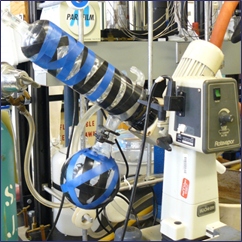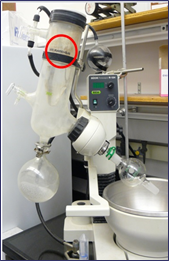Certain laboratory procedures require the use of a vacuum or the generation of a reduced pressure system. Weak points in the system can create implosion or explosion hazards. To ensure safe working conditions, follow the practices outlined below.
Personal Protective Equipment
Personal protective equipment should be used when working with systems under vacuum. Protect yourself from potential flying glass or debris by using safety glasses, goggle, face shield, and/or a blast shield when near an apparatus under vacuum.
Tubing and Equipment
Always use tubing (e.g., metal, thick walled rubber) that is rated for the pressure or vacuum conditions you will be using. Use tubing that is in good condition and free of cracks, holes, corrosion, or other signs of degradation. Do not use glassware that is thin, scratched, or has star cracks. Small defects in glassware are weak points where it can break. Avoid using round bottom flasks over 1000 mL in volume or glassware/equipment that is not approved for vacuum work.
Check Connections
Connections (e.g., ball joint, ground glass) in the system under vacuum require clamping (e.g., keck, hose, pinch) to ensure system integrity. Make sure all connections are properly greased, lubricated, or sealed. Small leaks in the system can cause the vacuum source to break or cause oxygen condensation if the system is cooled by liquid nitrogen.






Vacuum trap with connections clamped (arrows).

Trap inserted into Dewar flask (with polyethylene netting) with lid covered (towel). ) with lid covered (towel).
Traps
Use traps of appropriate size to prevent displaced chemical vapors from reaching the vacuum pump (portable or house vacuum). Make sure to properly secure all traps and Dewar flasks to avoid accidental movement that can cause glass breakage. Empty the trap when it becomes half full with condensed material or if the process is complete.
House vacuum systems are not to be used for cleaning debris from work surfaces. All vapors must be trapped before entering the house vacuum system.
Cold Traps
Cool traps to at least -60 ºC when displacing volatile or corrosive chemicals such as organic solvents and corrosive solutions. Cooling systems can be electric refrigerated systems, a mix of dry ice with isopropanol or acetone (-78 ºC), or liquid nitrogen (-196 ºC) (see WARNING below). Use Dewar flasks for liquid nitrogen; they should be at least three quarters full after trap insertion. Cover the Dewar flasks with foam, glass wool, towel, or foil to minimize evaporation and oxygen condensation in the coolant. Check the coolant level regularly, and refill when necessary.
WARNING! The system MUST be under vacuum before, during, and after using liquid nitrogen as a coolant; otherwise, liquid oxygen can condense in the trap and cause an explosion. Once under vacuum, submerge the trap in a Dewar flask containing liquid nitrogen. When done, remove the Dewar flask from the trap, and slowly open the system to atmospheric pressure.
Argon can also be condensed in flasks cooled by liquid nitrogen. This is extremely dangerous because when the cold bath is removed, the argon will instantly evaporate, expanding by a factor of 847 and causing an explosion. Venting the apparatus may not prevent an explosion.
Bleed Lines
Be sure to slowly bleed vacuum lines (breaching of the reduced pressure system) before disconnecting traps or other equipment.
Coat glassware
Glassware 250 mL or larger that is under vacuum should be wrapped in tape, netting, or plastic coating to minimize flying debris if the glass implodes. This includes flasks, receivers, and rotary-evaporator bump traps. Regularly check all glassware under vacuum, including wrapped glassware, for defects.

Rotary-evaporator taped to prevent implosion hazard.

Rotary-evaporator with plastic coated glassware.
Portable Vacuum Pumps (High Vacuum and Water Recirculating Aspirators)
Operate vacuum pumps only in places with good ventilation. Due to the heat generated by operating pumps, do not store volatile, corrosive, unstable, or flammable substances near them.
- Exhaust: Vacuum pump exhaust contains all chemicals that were displaced in the vacuum. If displacing hazardous substances, direct the pump exhaust into the fume hood or other building exhaust.
- Guards and secondary containment: All vacuum pumps that use a belt-driven motor must have belt guards. If possible, pumps should be placed in a secondary container to contain oil leaks/spills. The secondary container must be able to withstand the elevated temperatures given off by the pump.
- Maintenance: Change pump oil according to manufacturer recommendations and frequency of use to prevent damage to pumps. Rarely used pumps should still have pump oil changed every 6 months.Treat and dispose of used pump oil as contaminated waste (chemical waste UI# 9422 - Oil, vacuum pump).
Vacuum Gauges (Electronic, Mechanical and Mercury)
Use of mercury manometers/McLeod gauges is discouraged due to the toxic nature of mercury and safety issues involving the storage, use, and replenishing of mercury-containing devices. Consider using electronic and mechanical gauges that offer continuous and convenient vacuum level monitoring.
References
NRC (National Research Council). Prudent Practices in the Laboratory. Handling and Management of Chemical Hazards. National Academy Press: Washington, DC, 2011.